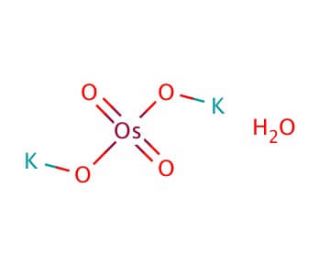
Click on image or enlarge button to enlarge

Potassium osmate(VI) dihydrate: sc-250764
Potassium osmate(VI) dihydrate (CAS 10022-66-9)
Application:
Potassium osmate(VI) dihydrate is a reagent used in the oxidative cleavage of carboxylic acids and olefins to ketones
CAS Number:
10022-66-9
Molecular Weight:
368.45
Molecular Formula:
K2OsO4•2H2O
Supplemental Information:
This is classified as a Dangerous Good for transport and may be subject to additional shipping charges.
For Research Use Only. Not Intended for Diagnostic or Therapeutic Use.
* Refer to Certificate of Analysis for lot specific data (including water content).
QUICK LINKS
Ordering Information
Description
Technical Information
Safety Information
SDS & Certificate of Analysis

Potassium osmate(VI) dihydrate is a reagent for the oxidative cleavage of olefins to ketone and carboxylic acid oxidative cleavage reagent. Further utilized in an intramolecular amidohydroxylation of carbamoyloxy-tethered olefins providing oxazolidinones. Potassium osmate(VI) dihydrate, commonly referred to as potassium osmate (VI) oxide, is a highly reactive chemical compound that finds broad applications across scientific and industrial domains. As a white, odorless, non-flammable powder, it readily dissolves in water but remains insoluble in alcohol and other organic solvents. This compound acts as a potent oxidizing agent, thus becoming a crucial component in numerous laboratory experiments and industrial processes. Due to its wide-ranging benefits, potassium osmate(VI) dihydrate is widely employed in scientific research, especially within the realms of biochemistry and molecular biology. Its versatile properties serve in synthesizing various organic compounds while facilitating the purification of proteins and nucleic acids. Moreover, it plays an essential part in the preparation and production of dyes, pigments, nitrocellulose, and cellulose acetate.
References:
- Visible Light Photocatalysis of Radical Anion Hetero-Diels-Alder Cycloadditions. | Hurtley, AE., et al. 2011. Tetrahedron. 67: 4442-4448. PMID: 21666769
- Access to any site directed stable isotope ((2)H, (13)C, (15)N, (17)O and (18)O) in genetically encoded amino acids. | Dawadi, PB. and Lugtenburg, J. 2013. Molecules. 18: 482-519. PMID: 23282537
- Total Synthesis of the Marine Phosphomacrolide, (−)-Enigmazole A, Exploiting Multicomponent Type I Anion Relay Chemistry (ARC) in Conjunction with a Late-Stage Petasis-Ferrier Union/Rearrangement. | Ai, Y., et al. 2018. J Org Chem. 83: 6110-6126. PMID: 29786446
- Development of a Convergent Enantioselective Synthetic Route to (−)-Myrocin G. | Tomanik, M., et al. 2020. J Org Chem. 85: 8952-8989. PMID: 32615040
- Design, synthesis, and antiviral activity of a series of CD4-mimetic small-molecule HIV-1 entry inhibitors. | Curreli, F., et al. 2021. Bioorg Med Chem. 32: 116000. PMID: 33461144
- Effect of nanocellulose polymorphism on electrochemical analytical performance in hybrid nanocomposites with non-oxidized single-walled carbon nanotubes. | Dortez, S., et al. 2022. Mikrochim Acta. 189: 62. PMID: 35031873
- Total synthesis and antimicrobial evaluation of (+)-hygrophorone B12 and its analogues. | Kamishima, T., et al. 2022. Sci Rep. 12: 7471. PMID: 35523990
- Design, Synthesis, and Bioassay of 2′-Modified Kanamycin A. | Yan, R., et al. 2022. Molecules. 27: PMID: 36364310